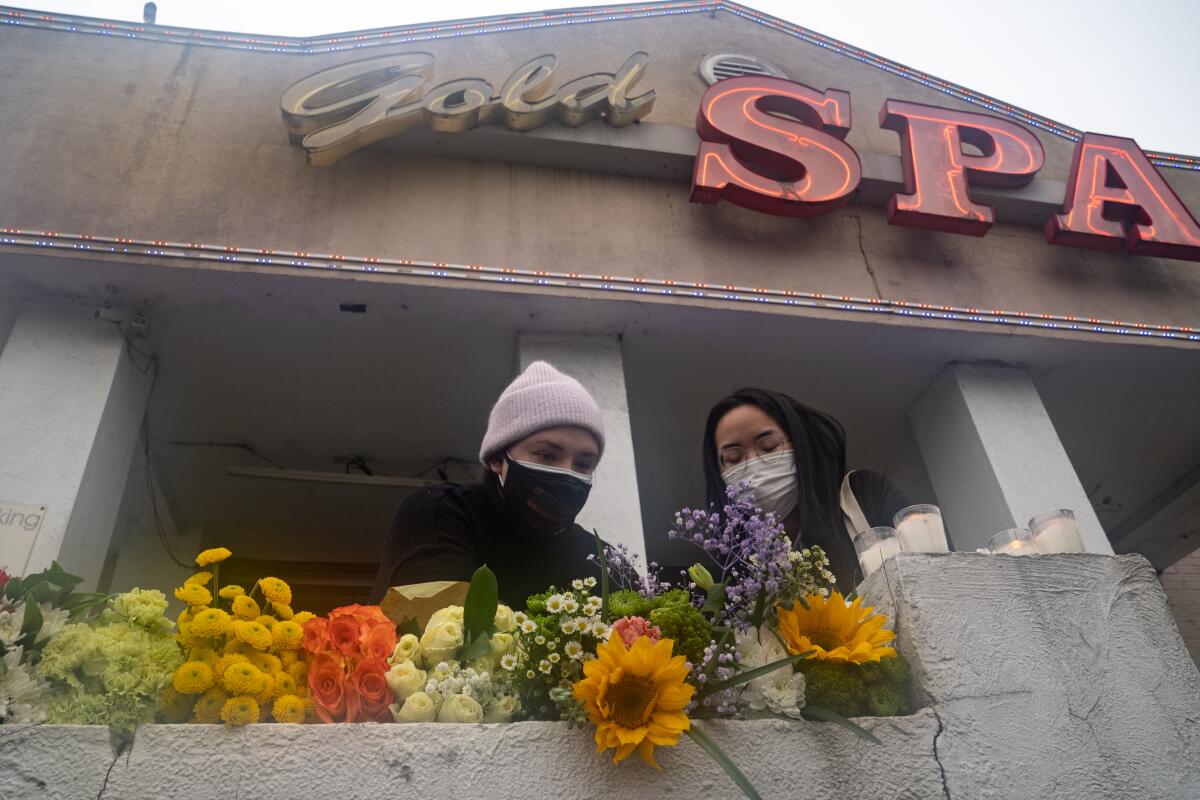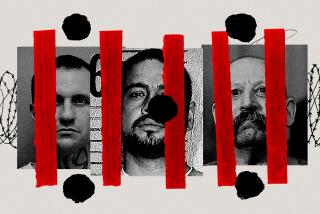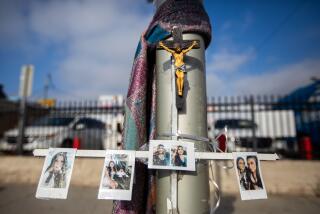Column: Do you think you have a good sense of who the Georgia shooter is? Don’t be too sure

- Share via
What do we talk about when we talk about murder suspects?
On Tuesday, Georgia authorities collared a 21-year-old white man, Robert Aaron Long, accusing him of killing eight people and wounding another at spas around Atlanta. Six of the dead are women of Asian descent.
The photo that surfaced soon after the arrest shows Long wearing glasses, with a mustache-less beard known as a chin curtain. According to Capt. Jay Baker of the Cherokee County Sheriff’s Office, Long took “responsibility for the shootings.”
The gender and race of most of the victims — together with current record levels of violence targeting Asian Americans and the broader rise of racially motivated violent extremism — suggests a hate crime. President Biden and Vice President Kamala Harris, who is of Asian descent, are headed to Atlanta on Friday to meet with advocates for Asian Americans and Pacific Islanders to gain perspective on the rise in anti-Asian hate crimes.
Long, we’ve been told, admits to the crimes but denies his actions had anything to do with race. But who would trust a confessed killer on his motives?
The Georgia authorities, evidently. Citing a “sex addiction” rationale also offered by Long, they told the world he “did not appear to be” motivated by racism. Then things got weirder. Sheriff’s Office spokesman Baker painted a sympathetic portrait of Long. “Yesterday was a really bad day for him and this is what he did,” he said.
Long’s family had evidently kicked him out of their house for his porn habits; his eviction made him “emotional,” according to Baker, who got the information from 911 callers. Long saw spa workers as a “temptation” that he “wanted to eliminate.” Anonymous callers also told 911 that Long wanted to “help” other sex addicts who suffer as he does.
Can this be real? What motivation besides homicidal racism and misogyny would drive someone to dehumanize Asian American women as temptations that required elimination by murder? And then to claim this was an act of charity for predatory men like himself?
Long’s apparently self-confessed “sex addiction” is a malady not included in the Diagnostic and Statistical Manual of Mental Disorders. (Dr. Martin Kafka, an expert on the subject, has argued for its inclusion, defining “hypersexuality disorder” in a 2009 research paper as a maladaptive set of behaviors associated with “clinically significant personal distress and social and medical morbidity.”)
Tyler Bayless, Long’s roommate at a halfway house for addicts, added God to the possible motive. Long, who grew up in the Southern Baptist Church, was “a deeply religious person,” Bayless explained, and his lasciviousness “would torture him.”
“He was very innocent-seeming,” an unnamed high school classmate of Long’s told the Daily Beast. “He was sorta nerdy and didn’t seem violent. He was big into religion.”
The emerging portrait was broadcast everywhere and quickly: Long as religious, innocent-seeming, tortured, emotional, addicted, nerdy, even charitable. And having a really bad day.
The bending over backward to come up with extenuating circumstances for the actions of a murder suspect who confessed to responsibility in the killings borders on the absurd.
The same context and compassion rarely characterizes the police treatment of nonwhite criminal suspects. George Floyd, detained for a negligible petty crime, got killed by police; Robert Aaron Long, arrested for multiple murders, got their sympathy.
Maybe we are asking the wrong people to evaluate murder suspects and ascertain their motives. After all, every time police officers shoot an unarmed Black man, they reveal how hopeless they are at threat assessment. A recent analysis of 5,367 fatal police shootings found that Black people (who make up 13.4% of the U.S. population) were killed at 2.6 times the rate of white people (76.3% of the population).
Maybe, just maybe, sheriff’s departments and police departments are not making life-or-death decisions based on specialized training but on flagrant bias. Certainly they’re too solicitous of some people and too suspicious of others.
And their errors in judgment are reinscribed for the public when the media is too quick to parrot “official” reports and to quote as character witnesses only classmates, roommates, neighbors and family members who share a suspect’s race, sex and milieu.
The better choice of whom to consult and trust is obvious in the Atlanta cases: workers at the spas Long says he frequented, the women he considered temptations, especially Asian American women. A compulsive consumer of porn might not strike those sources as deeply religious, nerdy or nonviolent.
Capt. Baker, whose own apparent promotion of anti-Asian rhetoric was recently discovered on social media, might be willing to believe a suspect like Long is free of racist motivations; it’s at least possible that the women he encountered in Atlanta-area spas would regard him and his actions differently.
Correctly characterizing a shooter’s motive is crucial. If the killings are deemed hate crimes, that designation can factor into sentencing. It can influence the FBI’s tabulation and evaluation of domestic terrorism. And it can lead to safeguards to protect populations targeted for discrimination and racist and sexist violence.
By contrast, when law enforcement officers make it clear that certain suspects will get their concern while others get abuse, they forfeit what’s left of public trust. And when the media doubles down on official accounts, they distort public perception.
These are the temptations that must be eliminated.
More to Read
A cure for the common opinion
Get thought-provoking perspectives with our weekly newsletter.
You may occasionally receive promotional content from the Los Angeles Times.










